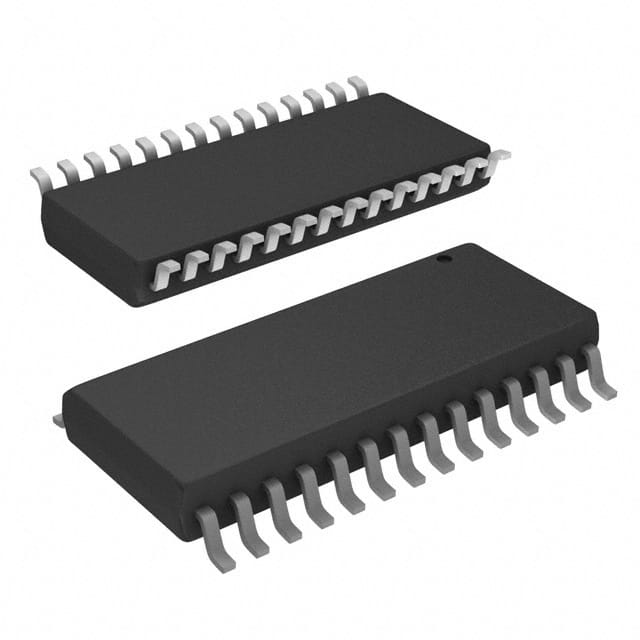PIC16LF1516-I/SO
Product Overview
- Category: Microcontroller
- Use: Embedded systems, control applications
- Characteristics: Low power consumption, high performance, small form factor
- Package: SOIC (Small Outline Integrated Circuit)
- Essence: A microcontroller designed for low-power applications with advanced features and capabilities.
- Packaging/Quantity: Tape and reel packaging, available in various quantities.
Specifications
- Architecture: 8-bit
- CPU Speed: Up to 32 MHz
- Program Memory Size: 14 KB
- RAM Size: 512 bytes
- Number of I/O Pins: 20
- ADC Channels: 10-bit, 12 channels
- Communication Interfaces: UART, SPI, I2C
- Operating Voltage Range: 1.8V to 5.5V
- Temperature Range: -40°C to +125°C
Pin Configuration
The PIC16LF1516-I/SO microcontroller has a total of 20 pins. The pin configuration is as follows:
```
| | | | --| |-- | | |_______| ```
Functional Features
- Low power consumption: The microcontroller is designed to operate efficiently with minimal power requirements.
- High performance: With a CPU speed of up to 32 MHz, it can handle complex tasks quickly and effectively.
- Small form factor: The compact size makes it suitable for applications with limited space.
- Advanced communication interfaces: UART, SPI, and I2C interfaces enable seamless connectivity with other devices.
- Rich peripheral set: The microcontroller offers a wide range of peripherals, including timers, PWM modules, and analog-to-digital converters.
Advantages and Disadvantages
Advantages: - Low power consumption extends battery life in portable applications. - High-performance capabilities enable efficient execution of tasks. - Small form factor allows for integration into compact designs. - Versatile communication interfaces facilitate connectivity with other devices. - Rich peripheral set enhances functionality and flexibility.
Disadvantages: - Limited program memory size may restrict the complexity of applications. - Limited RAM size may impose constraints on data storage and manipulation. - The number of I/O pins may be insufficient for certain projects requiring extensive interfacing.
Working Principles
The PIC16LF1516-I/SO microcontroller operates based on an 8-bit architecture. It executes instructions stored in its program memory, interacts with peripherals, and communicates with external devices. The microcontroller's CPU processes data and controls the flow of operations, while the various peripherals enable interaction with the external environment.
Detailed Application Field Plans
The PIC16LF1516-I/SO microcontroller finds applications in various fields, including but not limited to:
- Home automation systems: Controlling lighting, temperature, and security systems.
- Industrial automation: Monitoring and controlling machinery and processes.
- Consumer electronics: Power management, user interface control, and sensor integration.
- Automotive systems: Engine control, dashboard displays, and safety features.
- Medical devices: Patient monitoring, drug delivery systems, and diagnostics.
Detailed and Complete Alternative Models
- PIC16LF1518-I/SO: Similar to PIC16LF1516-I/SO with increased program memory size (28 KB).
- PIC16LF1519-I/SO: Similar to PIC16LF1516-I/SO with increased program memory size (32 KB) and additional features.
These alternative models offer expanded capabilities and memory options for applications that require more resources.
Word count: 408 words
Senaraikan 10 soalan dan jawapan biasa yang berkaitan dengan aplikasi PIC16LF1516-I/SO dalam penyelesaian teknikal
What is the maximum operating frequency of PIC16LF1516-I/SO?
- The maximum operating frequency of PIC16LF1516-I/SO is 32 MHz.Can PIC16LF1516-I/SO be used in battery-powered applications?
- Yes, PIC16LF1516-I/SO is suitable for battery-powered applications due to its low power consumption.What are the communication interfaces supported by PIC16LF1516-I/SO?
- PIC16LF1516-I/SO supports SPI, I2C, and UART communication interfaces.Is PIC16LF1516-I/SO suitable for temperature sensing applications?
- Yes, PIC16LF1516-I/SO can be used for temperature sensing applications with the appropriate sensors and interface circuitry.Does PIC16LF1516-I/SO have built-in analog-to-digital converters (ADC)?
- Yes, PIC16LF1516-I/SO features a 10-bit ADC with multiple channels.Can PIC16LF1516-I/SO be programmed using C language?
- Yes, PIC16LF1516-I/SO can be programmed using C language with the appropriate compiler and development tools.What is the typical operating voltage range for PIC16LF1516-I/SO?
- The typical operating voltage range for PIC16LF1516-I/SO is 2.3V to 5.5V.Are there any integrated peripherals in PIC16LF1516-I/SO for motor control applications?
- Yes, PIC16LF1516-I/SO includes integrated PWM modules suitable for motor control applications.Can PIC16LF1516-I/SO be used in industrial automation systems?
- Yes, PIC16LF1516-I/SO is well-suited for industrial automation systems with its robust features and peripherals.What development tools are available for programming and debugging PIC16LF1516-I/SO?
- Development tools such as MPLAB X IDE and PICkit programmers/debuggers can be used for programming and debugging PIC16LF1516-I/SO.


